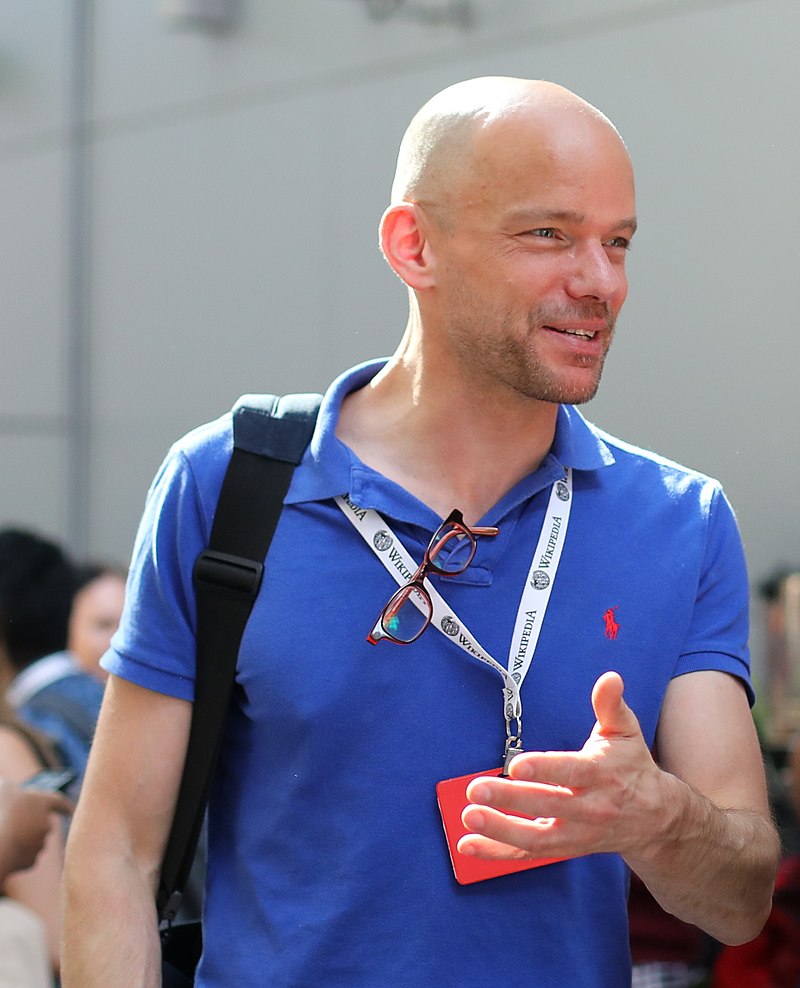KBCollectionHighlights
| << Back to index of this story | >> To the Github repo of this page |

50 cool new things you can now do with KB’s collection highlights - Part 3, Overviews per highlight
Latest update 12-116-2023

In this series of 5 articles I show the added value of putting images and metadata of digitised collection highlights of the KB, national library of the Netherlands, into the Wikimedia infrastructure. By putting our collection highlights into Wikidata, Wikimedia Commons and Wikipedia, dozens of new functionalities have been added: now you can do things with this digital collection that were not possible before.
In the previous part of this series I folded out the first 12 bits of the right hand knife. We saw which handy & useful overviews of all 70 highlights combined have become available as a result of the WikiProject Collection highlights. These include image galleries, alphabetical overviews & tables and an overview of existing and desired Wikipedia articles for our highlights.
In this third article I’m going to discuss the next group of 14 tools of the right hand knife, ie. I’m going to look at which new functionalities for individual highlights are available from now on.
Overviews per highlight
OK, time to start running….
13) Merging KB’s institutional and Wikimedia’s participative worlds for each highlight
As a start, I’d like to briefly go back to the metadata in the alphabetical overview we discussed in Part 2. Here, KB’s institutional and Wikimedia’s participative worlds are merged into a single overview. In the red box the world of KB’s collection highlights, with the browse book (Bekijk het topstuk op) and the explanatory notes (Toelichting), the inventory number (Inventarisnummer KB), and the persistent URL of the object in the KB catalog (KB catalogus - http://resolver.kb.nl…). In the blue box the world of Wikimedia, with the context of the highlight in Wikipedia, the images (and pdf) in Wikimedia Commons and the structured data in Wikidata.

Two metadata worlds in a single overview. Red box: KB links to KB’s collection highlights. Blue box: Wikimedia links to KB’s collection highlights. Screenshot Wikipedia d.d. 02-04-2021
14) Gallery page with individual images for each public domain highlight
For each (public domain) highlight, an gallery page with individual images is available, on which the images are presented in the correct order. Above the images a block of Wikidata-driven metadata for the entire work is displayed, including links to KB sources. Very handy to quickly and easily get an overview of the entire highlight. See for example the galleries of Buiten! Waar de vogels fluiten (Outside! Where the birds are singing) or the Wolfgang Hopyl Book of Hours.
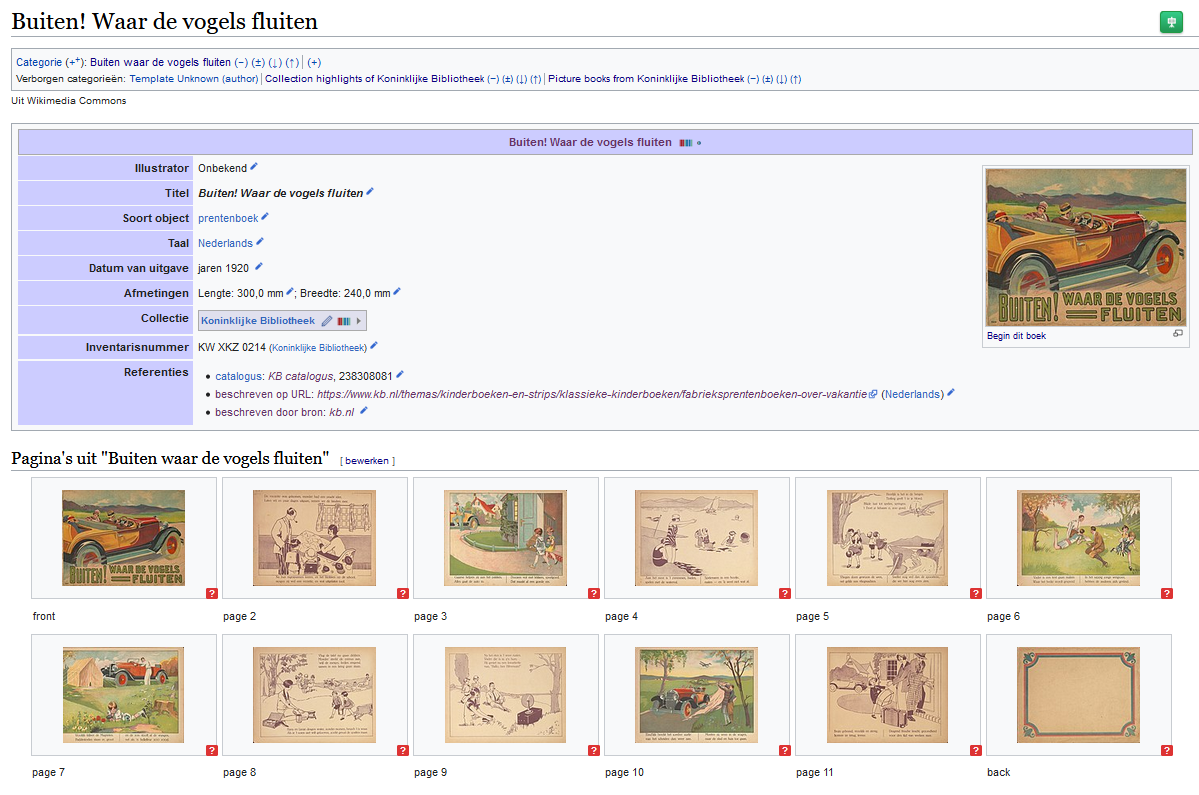
Gallery page for Buiten! Waar de vogels fluiten. Screenshot Wikimedia Commons d.d. 02-04-2021
15) Double page openings for most public domain highlights
In addition to the one page images in these galleries, double page openings, similar to those in the browse books on the KB website, are available for most highlights. See, for example, the openings of Visboek Coenen or those of Die hystorie vanden grooten Coninck Alexander.
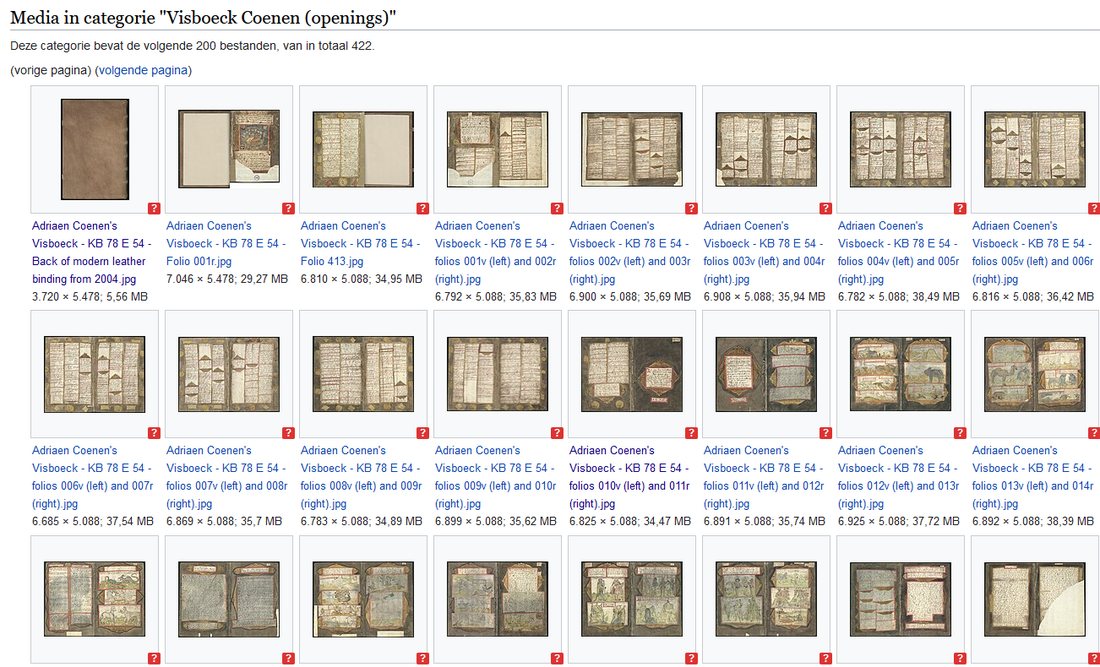
Double page openings for Visboek Coenen. Screenshot Wikimedia Commons d.d. 02-04-2021
16) Miniatures and/or cut-outs of interesting page sections for selected public domain highlights
In addition to the single pages (14) and double openings (15), for a number of highlights miniatures and/or cut-outs of interesting page sections are available as separte Commons files. For example, the 461 miniatures from Der Naturen Bloeme, those from Chroniques de Froissart or the Escher-like graphics from Kunst en Samenleving (Art and Society).
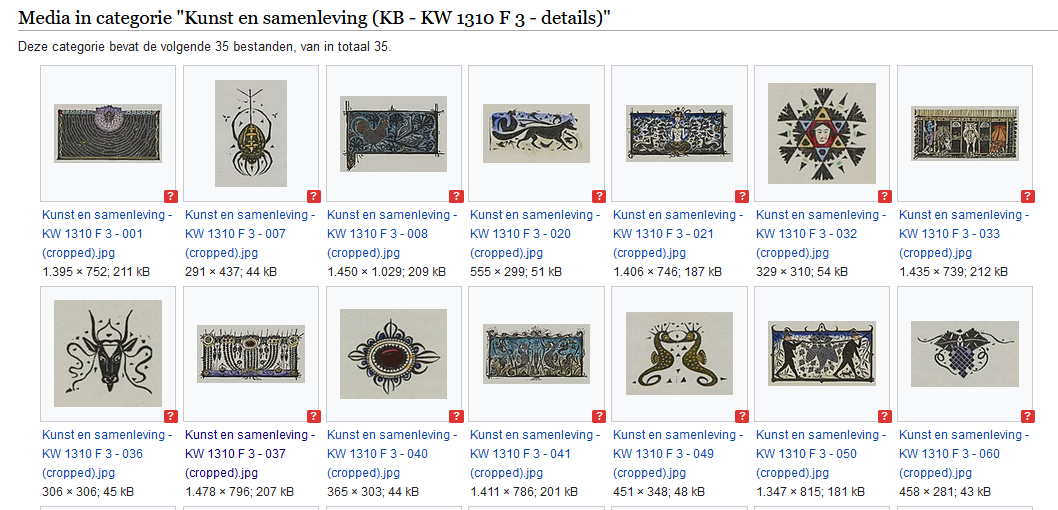
Escher-like graphics from Kunst en Samenleving . Screenshot Wikimedia Commons d.d. 02-04-2021
So far we looked at images related to KB’s collection highlights. However, besides images, other media types are now available as well.
17) Openly licensed audio tracks for selected highlights
You can listen to 11 audio tracks from the Beatrijs in which important stanzas from this poem are read by a former KB curator. These mp3s were ‘forgotten about’ in KB’s Soundcloud account and not yet available under Creative Commons licenses, making them unsuitable for Wikimedia purposes. We fixed the licensing and uploaded the files to Commons, making them more visible and reusable. As a result, tracks are now included as ‘auditory illustrations’ in the Dutch Wikipedia article about Beatrijs.
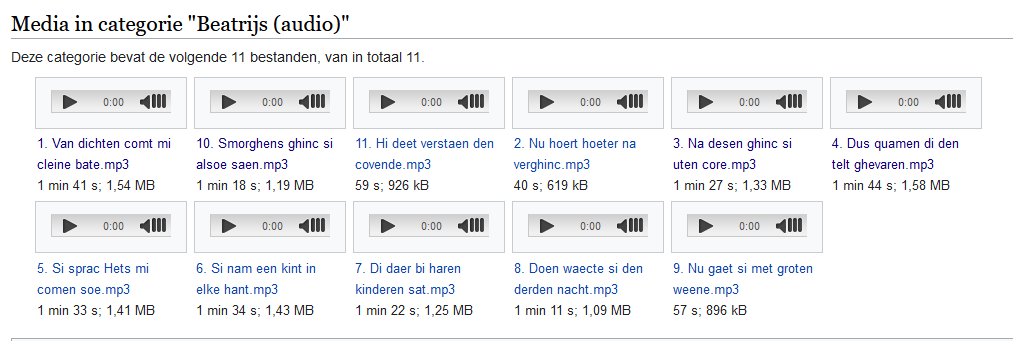
Audio tracks from the Beatrijs. Screenshot Wikimedia Commons d.d. 02-04-2021
18) Explainer videos for selected highlights
The KB curator for childrens’s books created an explainer video about De Nieuwe Rijschool (The New Riding school). So far this video is only availabe on YouTube, but because the KB released it under a free license it will be uploaded to Wikimedia Commons and included in the Dutch Wikipedia article De Nieuwe Rijschool a.s.a.p.
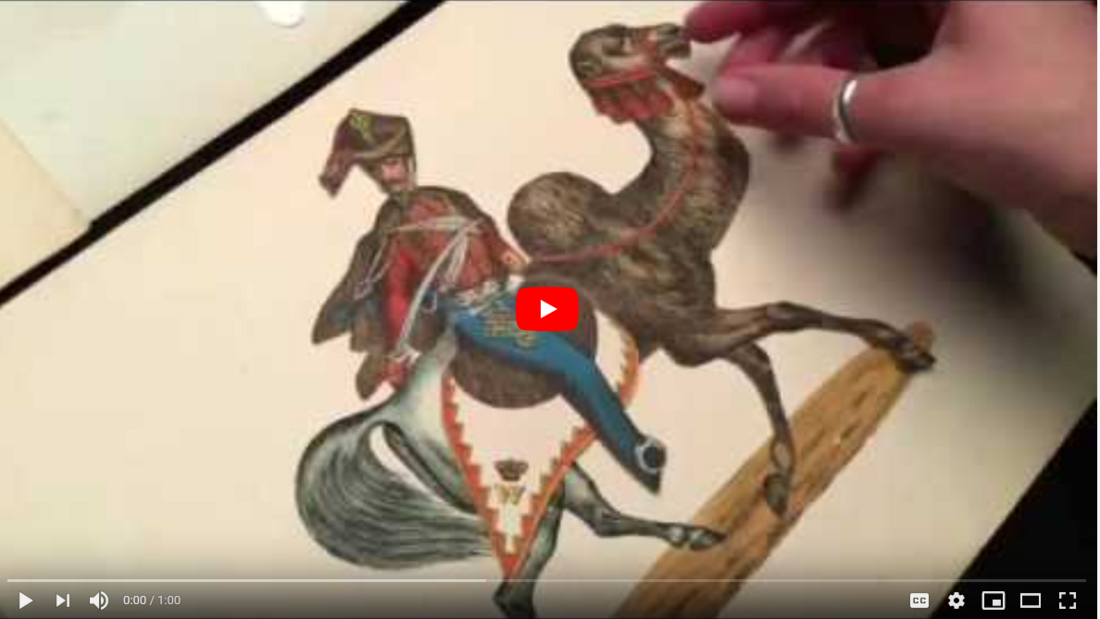
Video about De Nieuwe Rijschool. Screenshot Youtube d.d. 02-04-2021
Similarly, we are planning to make the Beatrijs video and the Gruuthuse manuscript video reusable for Wikimedia purposes as well.
19) Reusable introduction texts under CC0-licensing for each highligt
All introduction texts for the highlights on the KB website have been released under a CC0 Public Domain Mark. As a result, the texts for the Zweder Book of Hours, the ‘De boerderij’ picture book and all the other highlights have become freely reusable for everyone.
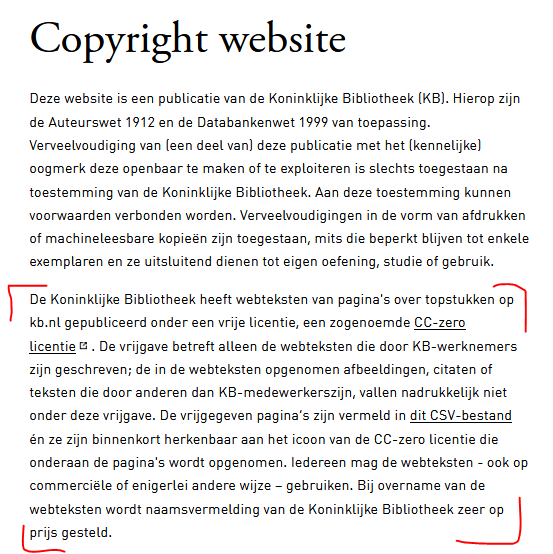
The paragraph in the red brackets explains the CC0 Public Domain Mark for the highlights’ introduction texts. Screenshot of the copyright section on KB’s website d.d. 12-04-2021
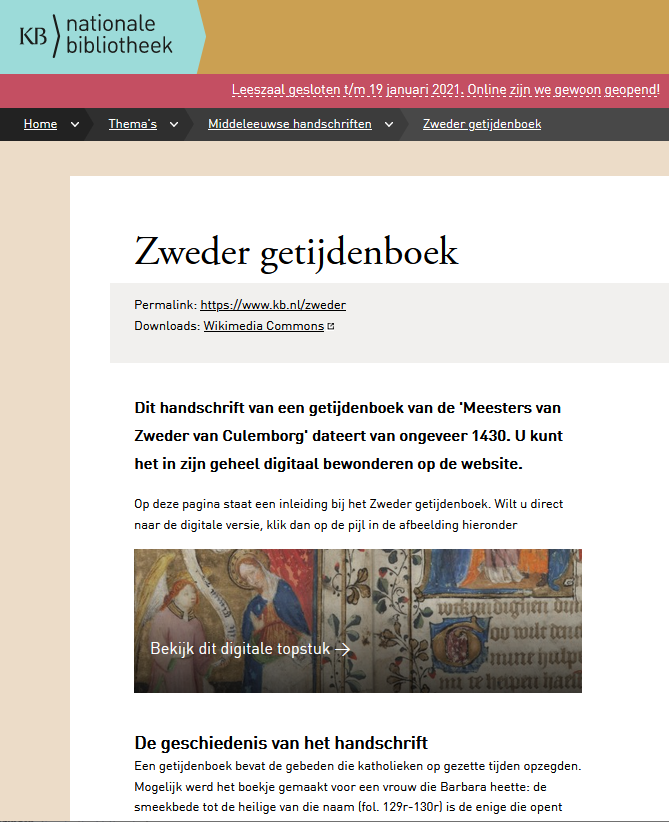
Introduction text for the Zweder Book of Hours, released under the CC0 Public Domain Mark. Screenshot KB website d.d. 12-04-2021
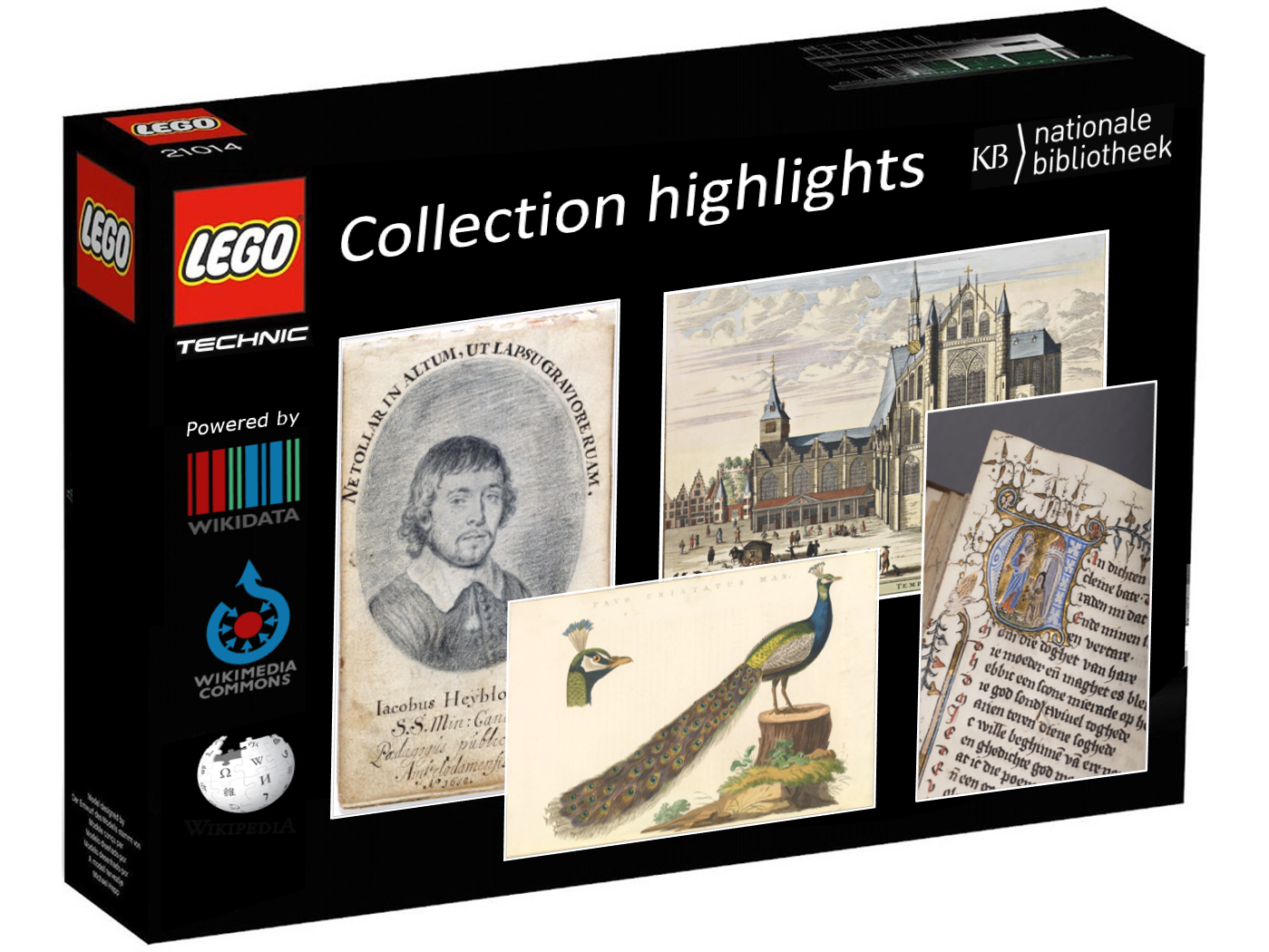
20) Openly licensed and freely reusable building blocks (images, audio, videos, texts) for each highligt
To summarize the points above: openly licensed and freely reusable building blocks are becoming increasingly available for our collection highlights:
- Images - single pages, double openings, miniatures, graphics, page details
- Audio files (see Beatrijs above)
- Video files
- Texts from the KB website
These reusable components make it easier for Wikipedia authors to create or expand articles about KB’s collection highlights. After all, you can now reuse (parts of) KB web texts in Wikipedia articles without risks of copyvio. Furthermore, all kinds of free illustrative images, videos and audio materials are available for enriching articles.
As a result, the recently created article about Koninklijke Bibliotheek 79 K 2 (= Zweder Book of Hours) shows strong similarities with KB’s text about that manuscript. Also new, illustrated article stubs have been written about the friendship books of Jacoba Maria Bolten, Petronella Moens and Samuel Johannes van den Bergh. And in the already mentioned overview of existing and wanted Dutch-language Wikipeda articles, you can see from the red links which highlights are in need of Wikipedia articles.
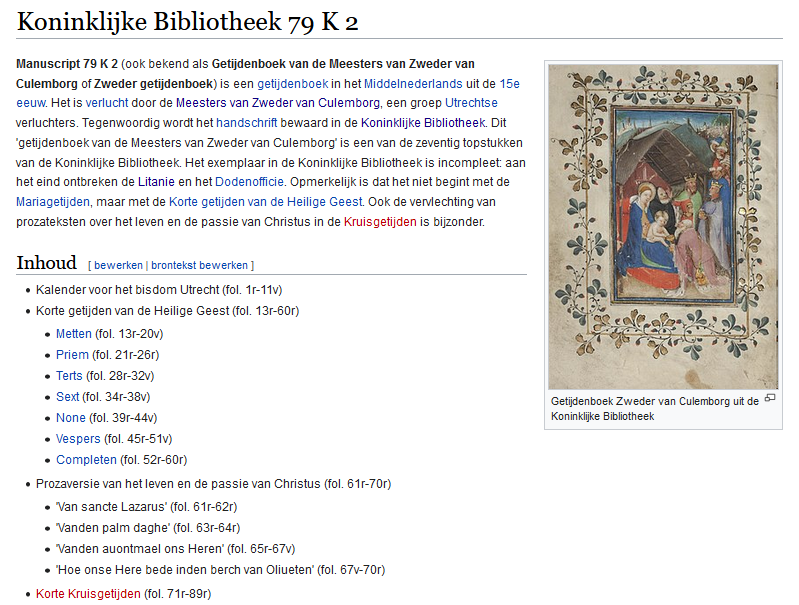
Dutch Wikipedia article about Koninklijke Bibliotheek 79 K 2, based on KB’s CC0 licensed web text about that manuscript. Screenshot Wikipedia d.d. 14-04-2021
21) KB citation template for use on Dutch Wikipedia
To clearly indicate that the text in a Wikipedia article is based on a text from the KB website, a KB citation template has been created. It states (in Dutch) that ‘the information on this page, or an earlier version of it, fully or partly originates from the KB website (kb.nl)’. You can see this template at the bottom of the Zweder Book of Hours article.

KB citation template at the bottom of the Zweder Book of Hours article. Screenshot Wikipedia d.d. 14-04-2021
To conclude this article, I would like to return to the people related to KB’s highlights, as we already did in points 9 and 10 in Part 2. More specifically: to the 141 people who contributed to the Album amicorum Jacob Heyblocq. We know all their names (see bottom of that page), but from that overview we don’t know what they looked like, what occupations they had, or what age they died at. But because all those contributors have been described in Wikidata, we can easily answer all these questions:
22) Facebook of contributors to the Album amicorum Jacob Heyblocq
There is a facebook, currently images of (only) 52 contributors are known…
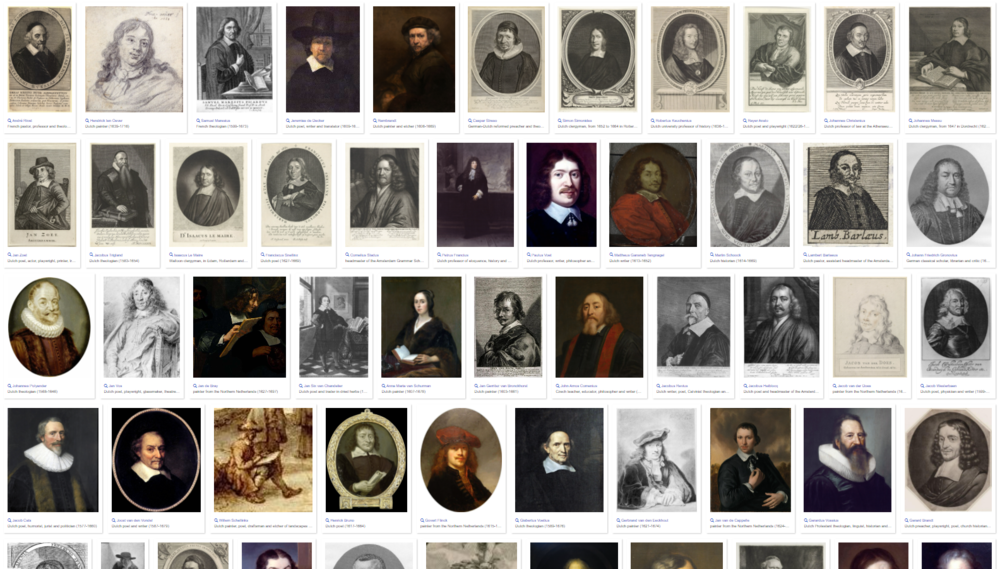
Gallery of contributors to the Album amicorum Jacob Heyblocq. Screenshot Wikidata d.d. 14-04-2021
23) Overview of gender distribution of album contributors
in terms of the gender distribution, only three women have contributed to this album: (Anna Maria van Schurman, Sara van Schilde and Cornelia van der Veer)…
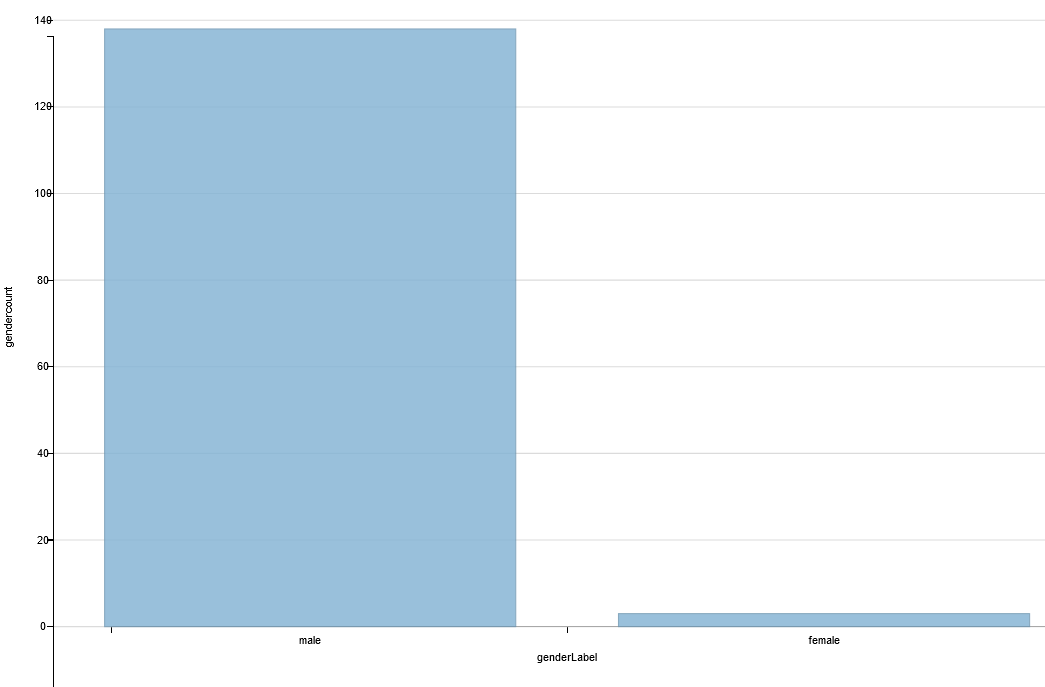
Gender distribution of contributors to the Album amicorum Jacob Heyblocq, 3 women. Screenshot Wikidata d.d. 15-04-2021
24) Overview of occupations of album contributors
in terms of occupations, mainly professors, clergy, poets, writers and painters have contributed to the album….
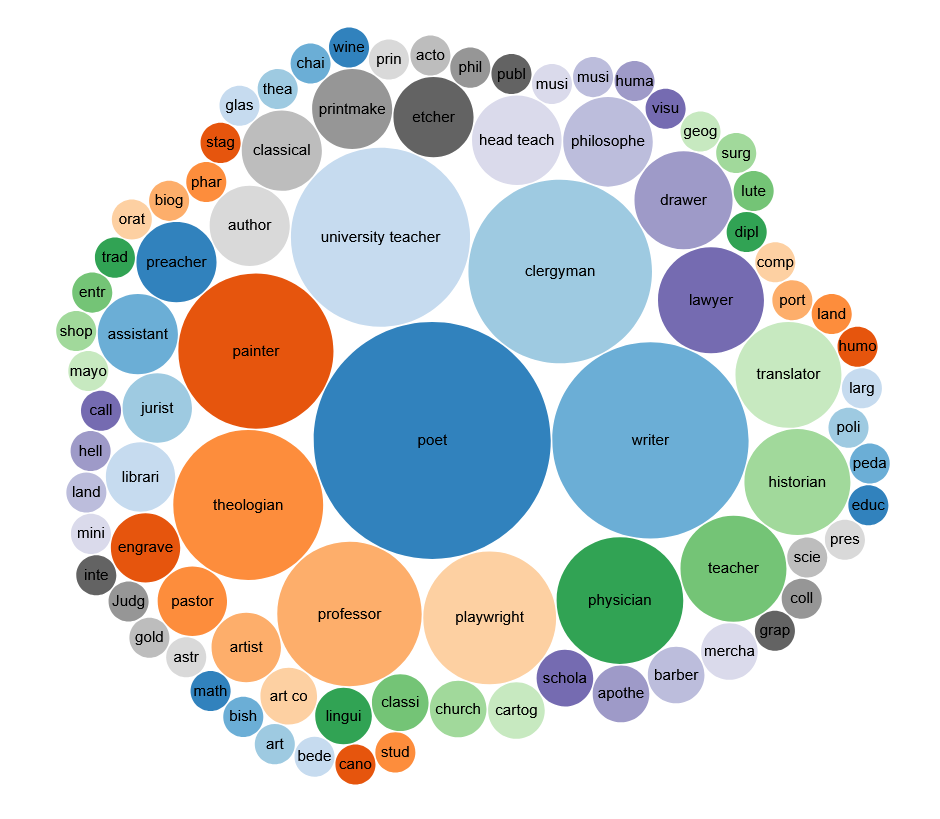
Occupations of the contributors to the Album amicorum Jacob Heyblocq. Screenshot Wikidata d.d. 15-04-2021
25) Overview of life spans of album contributors
and in terms of life spans, Caspar Staphorst is the contributor who lived longest, no less than 93 years. He is closely followed by the poet and writer Joost van den Vondel (92), slighlty older than Constantijn Huygens (91).
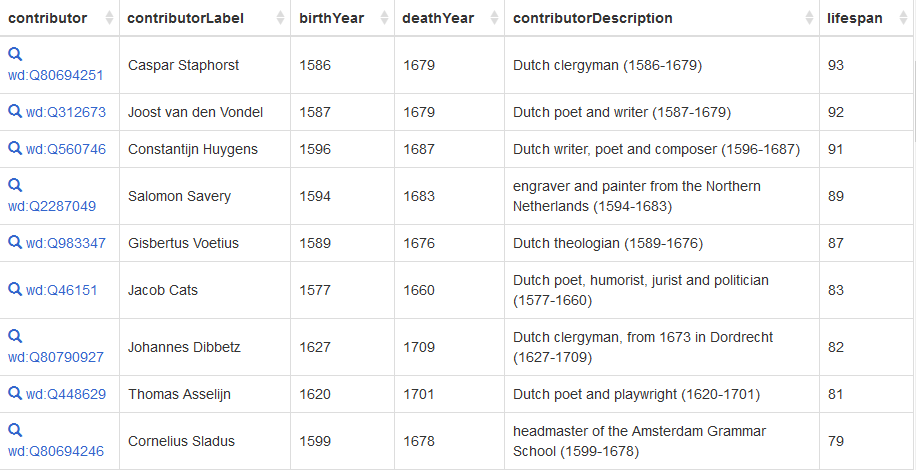
Life spans of the contributors to the Album amicorum Jacob Heyblocq. Screenshot Wikidata d.d. 15-04-2021
26) Map visualisations for selected highlights in which locations and places play key roles
OK, to finish off with, one last item: For highlights in which locations and places play key roles - eg. Atlas de Wit, Admirandorum quadruplex spectaculum (Fourfold spectacle of miracles) or Atlas van der Hagen - all kinds of useful data visualisations can be made.
The alphabetical place name index of Atlas de Wit on the KB website is a nice functionality, but visualising all those cities on a map and linking them to the historical maps is a pretty neat feature as well.
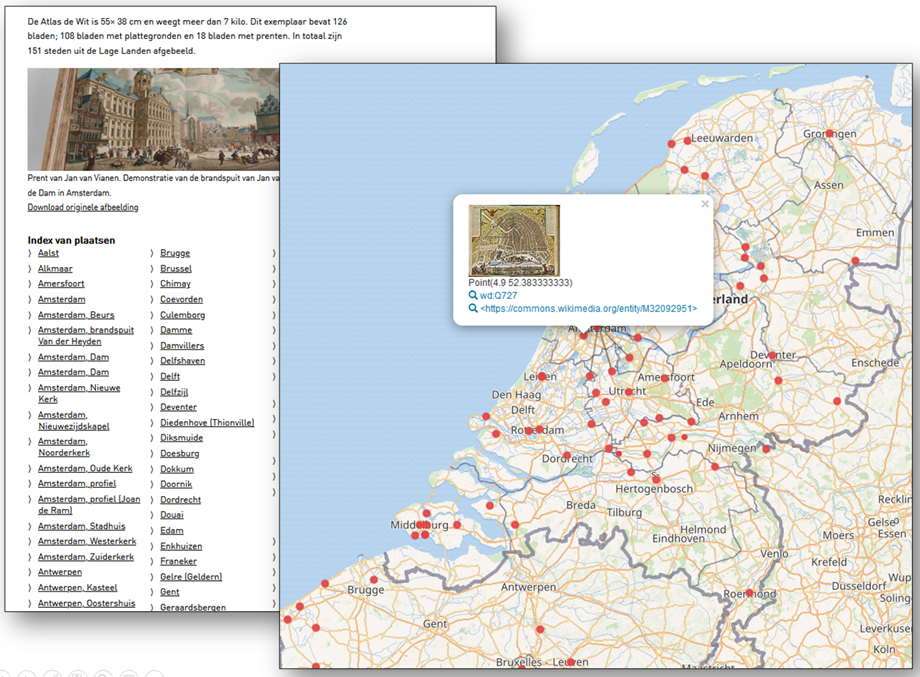
Map of cities in Atlas de Wit. Screenshot Wikimedia Commons d.d. 02-04-2021
Summary
For convenience and overview, let me summarize all the cool new things for KB’s collection highlights we have seen in this article:
13) Merging KB’s institutional and Wikimedia’s participative worlds for each highlight.
14) A gallery page with individual images for each public domain highlight.
15) Double page openings for most public domain highlights.
16) Miniatures and/or cut-outs of interesting page sections for selected public domain highlights.
17) Openly licensed audio tracks and
18) explainer videos for selected highlights.
19) Reusable introduction texts under CC0-licensing for each highligt
20) Openly licensed and freely reusable building blocks (images, audio, videos, texts) for each highligt.
21) A KB citation template for use on Dutch Wikipedia.
22) A facebook of contributors to the Album amicorum Jacob Heyblocq.
23) Overviews of the gender distribution,
24) the occupations and
25) the life spans of those contributors.
26) Map visualisations for selected highlights in which locations and places play key roles.
Up next
So far for this third article. In Part 4, Images, I’ll discuss which new & innovative functionalities for individual highlight images have become available as a result of the project.
About the author
Olaf Janssen is the Wikimedia coordinator of the KB, the national library of the Netherlands. He contributes to
Wikipedia, Wikimedia Commons and Wikidata as User:OlafJanssen
Reusing this article
This text of this article is available under the CC-BY 4.0 license.

Image sources & credits
- Swiss_army_knife_open,_2012-(01) – Joe Loong, CC BY-SA 2.0, via Wikimedia Commons
- Victorinox_Swiss_Army_SwissChamp_XAVT – Dave Taylor from Boulder, CO, CC BY 2.0, via Wikimedia Commons
- KB collection highlights LEGO® box - based upon the Villa Savoye box from the LEGO® Architecture series
